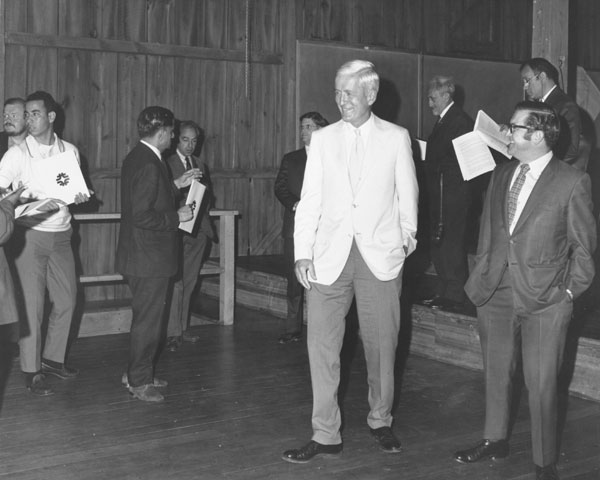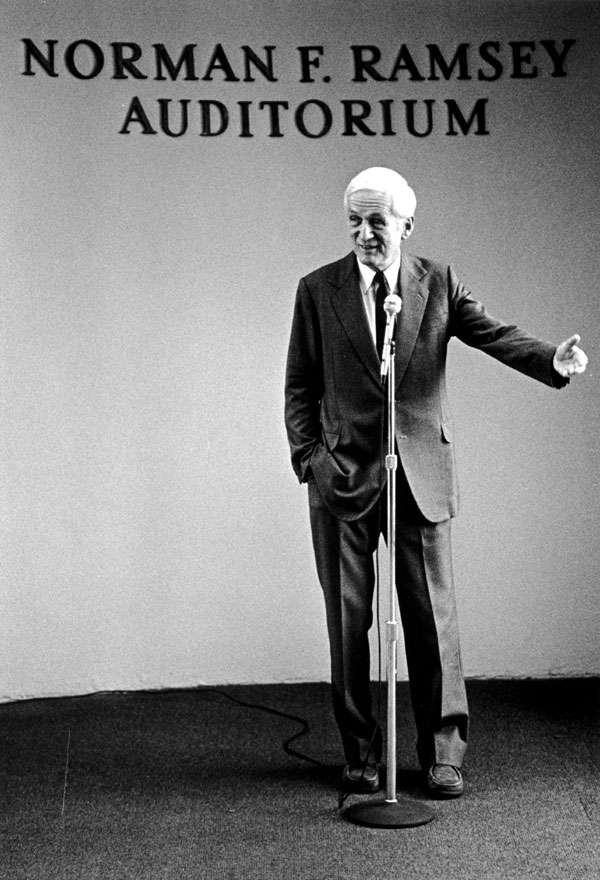In Memoriam: Norman Ramsey – Nov. 5
One of the Fermilab founders and former URA president Norman Ramsey died on Nov. 5. He was 96 years old.
Ramsey’s influence reached far into the scientific and political realms. He was a pioneer in magnetic resonance, a Harvard professor and an important participant in the development of radar and the atomic bomb in World War II. After the war, Ramsey chaired the President’s Science Advisory Committee, which worked in tandem with the General Advisory Committee to the Atomic Energy Commission. In April of 1963, Ramsey put forth a report recommending the design and construction of a 200 BeV accelerator. Informally, the study became known as the Ramsey Report.
“Norman was the catalyst that enabled the creation and evolution of Fermilab from 1963 into the 1980s,” Fermilab historian and archivist Adrienne Kolb said. “He assured Fermilab’s continuity and had all the right answers to quiet any challenges, wherever they surfaced.”
The Universities Research Association, Inc. (URA) was assembled in 1965 to manage the project that was known as the National Accelerator Laboratory (NAL). Ramsey became president of the URA in 1966. He took a sabbatical in 1973, but returned to the position in 1974. He remained president until 1981, taking another short break in 1979. The idea of a national laboratory managed by a consortium of universities, and not by a single institution, was revolutionary. Ramsey developed the concept through his work on the Ramsey Report and followed through with the creation of NAL.
“Norman kept everyone focused on the goal of a National Accelerator Laboratory,” Kolb said. “People respected, appreciated and trusted him.”
Ramsey asked Bob Wilson to be the first director of NAL, which became Fermilab in 1974.
During the early 1970s, Ramsey dedicated one day a week to high-energy physics affairs. As a professor at Harvard, he would leave Cambridge, Mass. at 6 a.m. to go to Washington. There, he intervened on what he thought was the proper side of whatever problems were presented, including financial and management concerns.
“Norman was a staunch supporter of Bob and some of the nonconventional philosophy he had in managing the project,” said Ned Goldwasser, the first deputy director of NAL. “We had aggressive timelines and we built as economically as possible. Some people thought it was courageous to manage the project the way Bob did; others thought it was crazy. It was very important that we had Norman’s support in Washington.”
After spending the morning in Washington, Ramsey would fly to Chicago, arriving at Fermilab in the early afternoon. He’d spend a few hours meeting with Wilson and Goldwasser.
“We were completely frank with one another,” Goldwasser said. “Bob and I didn’t always agree with each other, but Norman was very good at bringing us together.”
According to Goldwasser, Ramsey dove deeply into the affairs of the laboratory. He wanted to know about the concerns and successes of every user. He would spend the latter part of the afternoon walking around Fermilab, asking questions.
Dick Carrigan, the former director of personnel services, would meet with Ramsey during this time to discuss personnel business, such as hiring for the laboratory.
“Norman was famous already,” Carrigan said. “He was intimidating, but very friendly. He was always direct and dynamic.”
John Peoples, Fermilab’s third director, remembers Ramsey’s visits to Fermilab as well.
“Norman would come to the laboratory regularly during its construction and the first few years of operation. I was fairly low down on the totem pole, so I didn’t get to talk a great deal with him but I knew that the 1963 Ramsey report was the crucial element in the decision of Congress and the president to fund the National Accelerator Laboratory,” Peoples said. “The fact that the laboratory exists at all is, in large part, thanks to him.”
Later, after Bob Wilson had resigned and the URA Board of Trustees had begun the searching for his successor, Peoples had more chances to interact with Ramsey.
“Norman helped to prepare many of us for the changes that were to come,” Peoples said. “The laboratory was in turmoil for several months while the Board did its work. We were fortunate that Leon Lederman accepted the call and the laboratory regained its momentum.”
And while Ramsey worked to make Fermilab successful, he was also working on his own physics research.
“He was doing some superb science during this time, too,” Peoples said. “He was a very energetic guy.”
In 1989, Ramsey won the Nobel Prize for his development of the separated oscillatory field method of measurement, which led to the development of the atomic clock. He is also highly recognized for his work in magnetic resonance, the applications of which are still used in medical MRI machines.
“Norman was this tall, distinguished and white-haired presence,” Kolb said. She met him in 1985, four years after Fermilab’s auditorium was named in his honor. “He was so accomplished; you knew all that he had done during the war and as president of URA, and were in awe, yet he was so approachable. He would always make time to talk.”
Ramsey was known as logical and reasonable, as well as diplomatic.
“Norman was a marvelous human being. His opinions were always well thought out. He didn’t express his views easily or lightly,” Goldwasser said. “When he made up his mind, he had good analysis and reason to take his position.”
Ramsey is survived by his wife Ellie and four daughters: Margaret Kasschau, Patricia Ramsey, Winifred Swarr and Janet Farrell. He is also survived by two stepchildren: Marguerite and Gerard Welch; as well as eight grandchildren and nine great-grandchildren He also left a long scientific and political legacy.
“He must’ve been tough-minded to get this place built,” Peoples said. “It was his vision to have a national accelerator laboratory – a place run by universities and not under the control of a single institution. He wanted a laboratory open to all users. And he did it.”





